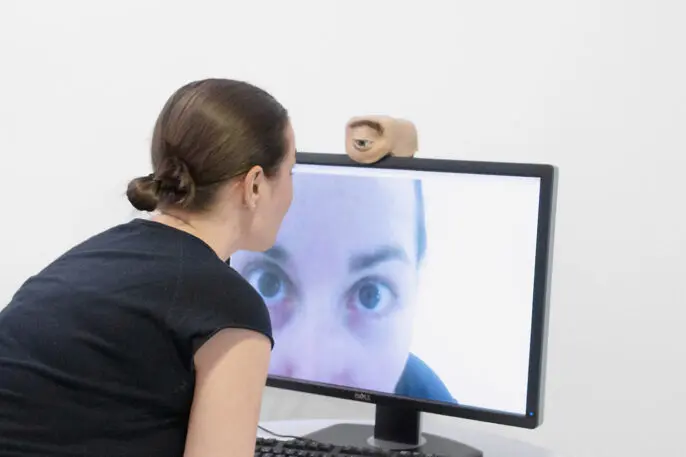In case you forgot, there’s an internet-connected camera looking at you right now. Whether it’s on your phone or laptop, it’s staring at you, right in the face. There’s literally a tool that can broadcast you to the world, right there, all the time! But of course, its sleek design melts the sensation away.
But could you ignore that camera if it were, say, a disembodied human eye?
That’s the tacit question explored by Marc Teyssier, a postdoctoral researcher at Saarland University, in his latest project, Eyecam. After building a phone that had skin that could feel, and another that had a finger built to touch you back, Teyssier’s final project in his “anthropomorphic series” places a functional webcam inside a fleshy eye that sits on top of your computer. With built-in face-tracking intelligence, the eye doesn’t just gaze blankly at you with a glass stare; it darts around to follow your every move and occasionally blinks. It looks alive.
At first sight, the fleshy eye is certainly a bit revolting. However, Teyssier’s intent isn’t that his creation be grotesque. It’s both an exploration of our relationship with technology, and I’d argue, a critique of the very practice of building human-computer interfaces. In giving our technology more humanity, he’s pushing the boundaries of industrial design and UX to a natural conclusion: That rather than shaping objects to fit our lives, we build these objects into something more akin to life itself. Put differently, if we’re touching our phones all day anyway, why don’t they have skin, nerves, and all of the biological intricacies to understand us naturally?
“The skin, and flesh, is something we are used to seeing in our everyday life,” says Teyssier, “yet when it’s on devices, it feels uncanny.”
Creating the Eyecam was a very DIY process. Teyssier 3D-printed a half-sphere to serve as the globe of the eye. He printed out a pupil for it and then covered the surface with glossy, transparent nail polish to make it appear wet. The camera lens serves as the pupil itself. Meanwhile, motor hardware hides beneath the flesh-like silicone skin to move the eye. All in all, the project required 20 prototypes for Teyssier to get it right.

So what’s next for his work? Teyssier teases that he’d like to bring some of these devices to a public space, to see how people would react under real-world conditions. (Which sounds like both a lively bit of research and a highly entertaining Netflix Original.) But having finished his anthropomorphic trilogy, Teyssier is ready to step away from all of the skin.
“Now that I used devices to critique the state of technology and of our relation with devices, I want to use this knowledge to create more useful and responsible tech,” he says.
Recognize your brand’s excellence by applying to this year’s Brands That Matter Awards before the early-rate deadline, May 3.
